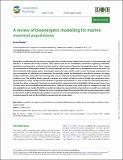Files in this item
A review of bioenergetic modelling for marine mammal populations
Item metadata
| dc.contributor.author | Pirotta, Enrico | |
| dc.date.accessioned | 2022-06-30T12:30:11Z | |
| dc.date.available | 2022-06-30T12:30:11Z | |
| dc.date.issued | 2022 | |
| dc.identifier | 280227323 | |
| dc.identifier | 28b4ae21-c699-4794-9db8-15660292af2f | |
| dc.identifier | 85133625740 | |
| dc.identifier | 000814333800001 | |
| dc.identifier.citation | Pirotta , E 2022 , ' A review of bioenergetic modelling for marine mammal populations ' , Conservation Physiology , vol. 10 , no. 1 , coac036 . https://doi.org/10.1093/conphys/coac036 | en |
| dc.identifier.issn | 2051-1434 | |
| dc.identifier.other | Bibtex: 10.1093/conphys/coac036 | |
| dc.identifier.uri | https://hdl.handle.net/10023/25588 | |
| dc.description | This work was supported by the U.S. Office of Naval Research [grant number N000142012392] and the Marine Mammal Commission [award number MMC21-056]. | en |
| dc.description.abstract | Bioenergetic models describe the processes through which animals acquire energy from resources in the environment and allocate it to different life history functions. They capture some of the fundamental mechanisms regulating individuals, populations and ecosystems and have thus been used in a wide variety of theoretical and applied contexts. Here, I review the development of bioenergetic models for marine mammals and their application to management and conservation. For these long-lived, wide-ranging species, bioenergetic approaches were initially used to assess the energy requirements and prey consumption of individuals and populations. Increasingly, models are developed to describe the dynamics of energy intake and allocation and predict how resulting body reserves, vital rates and population dynamics might change as external conditions vary. The building blocks required to develop such models include estimates of intake rate, maintenance costs, growth patterns, energy storage and the dynamics of gestation and lactation, as well as rules for prioritizing allocation. I describe how these components have been parameterized for marine mammals and highlight critical research gaps. Large variation exists among available analytical approaches, reflecting the large range of life histories, management needs and data availability across studies. Flexibility in modelling strategy has supported tailored applications to specific case studies but has resulted in limited generality. Despite the many empirical and theoretical uncertainties that remain, bioenergetic models can be used to predict individual and population responses to environmental change and other anthropogenic impacts, thus providing powerful tools to inform effective management and conservation. | |
| dc.format.extent | 16 | |
| dc.format.extent | 1185074 | |
| dc.language.iso | eng | |
| dc.relation.ispartof | Conservation Physiology | en |
| dc.subject | Population consequences of disturbnce | en |
| dc.subject | Pinnipeds | en |
| dc.subject | Individual-based modelling | en |
| dc.subject | Energy budgets | en |
| dc.subject | Cetaceans | en |
| dc.subject | Bioenergetic models | en |
| dc.subject | GC Oceanography | en |
| dc.subject | QH301 Biology | en |
| dc.subject | SDG 14 - Life Below Water | en |
| dc.subject.lcc | GC | en |
| dc.subject.lcc | QH301 | en |
| dc.title | A review of bioenergetic modelling for marine mammal populations | en |
| dc.type | Journal item | en |
| dc.contributor.institution | University of St Andrews. School of Biology | en |
| dc.contributor.institution | University of St Andrews. Centre for Research into Ecological & Environmental Modelling | en |
| dc.identifier.doi | https://doi.org/10.1093/conphys/coac036 | |
| dc.description.status | Peer reviewed | en |
This item appears in the following Collection(s)
Items in the St Andrews Research Repository are protected by copyright, with all rights reserved, unless otherwise indicated.

